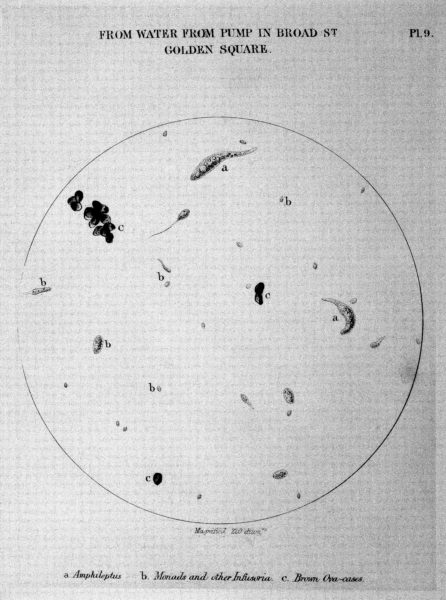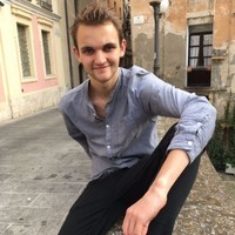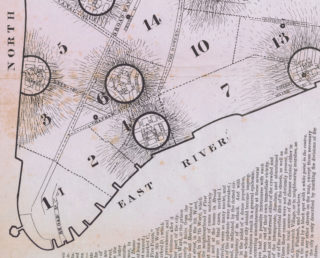Harry Blain
Getting one artist to settle on a concept is hard enough. How, then, can eight—each from different disciplinary backgrounds—not only find some unity of thought, but a final conceptual product?
This was the near-herculean challenge facing the team of researchers developing artist Mariam Ghani’s project Dis-Ease through the Center for Humanities, while Ghani was in residence at the New York Public Library and the Graduate Center, CUNY in 2017–19. The work was created for the exhibition Germ City: Microbes and the Metropolis at the Museum of the City of New York (September 14, 2018–April 28, 2019), the New York–branch of Contagious Cities—a multi-city project (Geneva, Hong Kong, New York) funded by Wellcome that explores the interplay of people and pathogens in urban contexts.
Over the summer of 2018, an unlikely mix of minds trained in political science, history, literature, philosophy and medicine somehow aimed to produce a coherent piece of art straddling themes ranging from urban growth and decay and anxieties about social order, to miasma and germ theory and metaphors of disease over time.
The conceptual and logistical tasks were numerous. Typologies, narratives, films, images; tags, folders, libraries, bibliographies. All to culminate in an essay-film fitting for the context of New York’s Germ City and the global Contagious Cities—not to mention Ghani’s towering artistic identity, forged on subjects ranging from the “disappeared” of Guantanamo Bay to modern-day racial segregation in the United States.
In the broadest sense, our work aimed to grapple with the historical trajectory of how we understand illness. Have our metaphors about illness changed over time? Do changes in how we speak about diseases affect how we treat them?
With all the associated benefits and complications, we started with very broad parameters. Although we felt comfortable limiting our selection of cities to New York, London, Hong Kong and Davos, we were immediately confronted with the more intractable question of choosing our diseases. The conversation was just as bizarre as it sounds: “Come on, we must have cholera”; “The plague is too good to drop”; “I vote for syphilis.”
We quickly realized that discussions of this kind would not be resolved through more highly regimented meetings or the drawing of more rigid lines of inquiry. Of course, we wanted to narrow our scope, but each discovery of a new pamphlet, photograph or newsreel would open up its own world of themes and ideas. And although our diverse interests and academic backgrounds lent themselves to at least some clearly defined division of labor, none of us could resist pursuing new threads when they emerged.
Out of both necessity and creative license, our approach became iterative. Intellectual boundaries were deliberately defined loosely; tangents were, in many ways, welcomed.
However, the story was starkly different when it came to the more practical questions often ignored by researchers: data storage, naming conventions, file sharing, citations. The standards for each were precisely laid out on day one, and those of us not fully versed in the underpinning technological tools—Zotero and Slack—were promptly given a crash course in each. Here, the steady hand of seasoned archival researchers, with no shortage of experience witnessing logistical calamities, ensured that we did not spiral into one.
This, then, was the basic framework: develop your thoughts freely, but document them fastidiously.
The results, after our initial weeks of work, were predictable: a shared library bursting at the seams. On a personal level, going through these sources could be a bizarre experience. Many of us found ourselves confronted with outright absurdity at some moments, and chilling solemnity at others. We had intricate 19th-century maps of cholera outbreaks in London, photos of unmarked graves for AIDS victims on New York’s Hart Island, books prescribing “positive thoughts” as a cure for cancer, recordings of eerie influenza- and tuberculosis-themed nursery rhymes, old government videos depicting venereal diseases as menacing femme fatales. If looking at “disease” in the abstract was simple enough, studying it in all its intimacy and humanity was often confronting - especially when the content was not a historical curiosity, but an ongoing struggle for recognition, dignity and respect.
Practically, of course, we still had to figure out how all of this would come together. Our weekly meetings became increasingly precious, as the raw research materials accumulated. Undoubtedly, our rapidly assembled online platforms were indispensable, but there is no substitute for regular face-to-face discussion. Only through this somewhat old-school method could we get a real sense of where our thought processes converged and where they pushed in different directions.
We would find, for instance, that the images of masked police officers during the 2003 SARS crisis in Hong Kong paired powerfully with those of European soldiers during the influenza epidemic of 1918–19. But we would also find that other narratives—like the evolving images of doctors throughout history—were lacking coherence.
Cutting is always harder than collecting, and it might be expected that the editing work of multiple brains is less precise and discriminating than one. Yet, somewhat surprisingly, our collaborative style seemed to aid our refinement process. When you spend weeks buried in your own documents, thoughts and reflections, it is easy to become attached to what you’ve produced. Without a gentle (or not so gentle) “this doesn’t quite work” or “toss this out,” researchers get tunnel vision.
We, however, were uniquely able to pivot quickly in our focus and outlook from week to week. Aside from the back-and-forth of meetings, we developed a rather primitive Zotero coding scheme to nurture this flexibility. Around the mid-point of the project, Mariam would simply label an item in our shared library with “Find more” or “Useful”—and as we progressed further, “Request scan” or “Get high-res.”
In this way, we started to chart a general path toward completion: dispensing with what we didn’t need, following up on what we liked, and figuring out how to get it.
The last task—physically acquiring the final, usable material—often goes badly in audio-visual research, largely because copyright complications rudely intervene. Again, though, this is where our starting mantra of bibliographical precision showed its worth: no item could be uploaded without our own notes on not only why we selected it, but who owned it, whether they were willing to share it, and if it came with a price tag.
Still, the road between conceiving of a final project and ultimately delivering it is never a smooth one. There were late nights and early mornings, hastily arranged Skype calls and slightly panicked Slack threads.
When we attended the opening of Germ City on September 13, we saw all the iterations, debates, and forward and backward strides of our improvised six-week collaboration. Inevitably, a small fraction of our initial ideas actually appeared on screen, with our final product more narrowly focused on New York, anatomical images through history, and visual representations of germs and microbes.
But if it was slightly strange to think that nearly everything was for one short film displayed in one corner of a cavernous museum, it was also uniquely gratifying to see the labor of eight very different minds distilled so elegantly in a single place.
The other researchers / collaborators on Dis-Ease were Christian Lewis, Dilara O'Neil, Eileen Clancy, Jacob Clary, Josh LaMore, and Juliana Broad.


